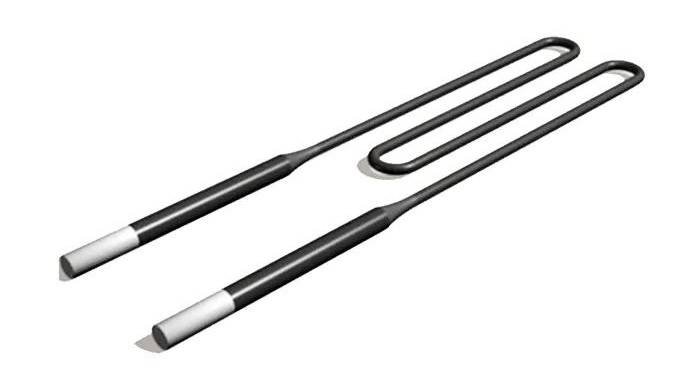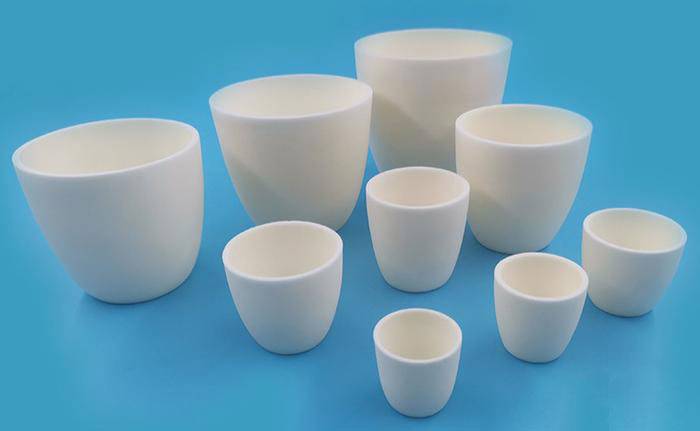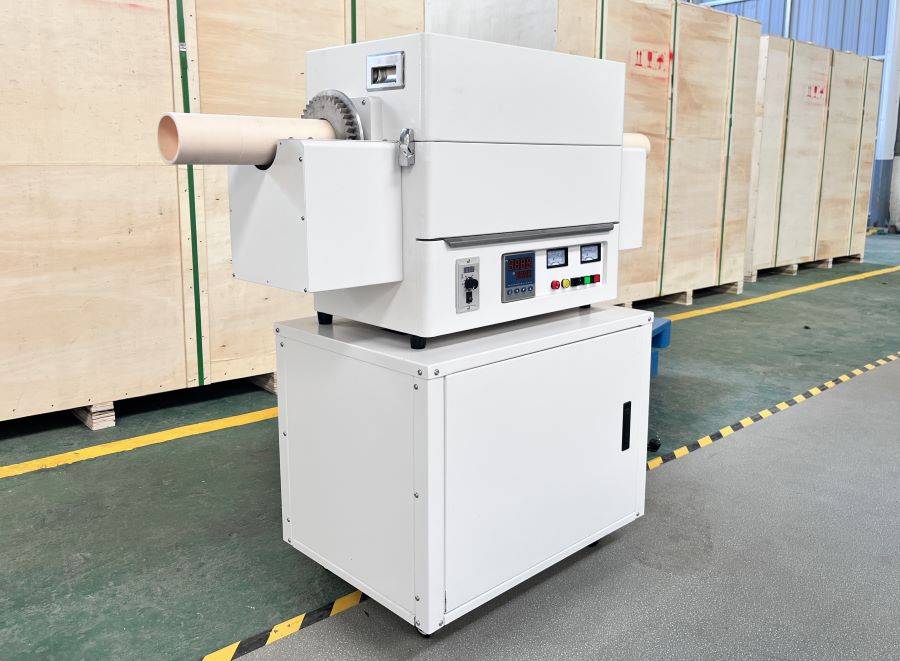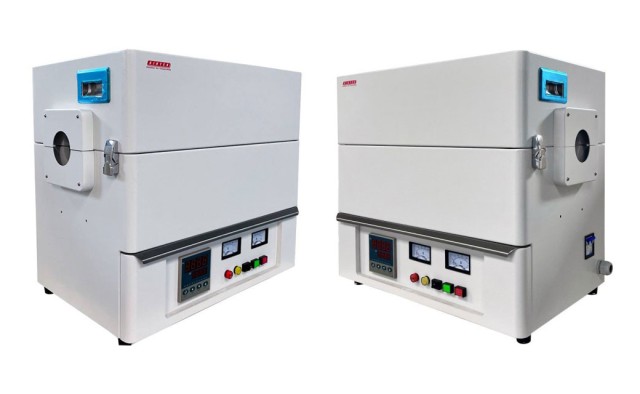온도 고려 사항
최대 및 연속 작동 온도
실험실 실험을 위해 튜브 퍼니스를 선택할 때는 온도 범위가 최고 온도 요구 사항에 정확하게 부합하는지 확인하는 것이 중요합니다. 여기에는 퍼니스가 달성할 수 있는 최대 온도를 파악하는 것뿐만 아니라 장시간 동안 이 온도를 일관되게 유지할 수 있는 능력을 이해하는 것도 포함됩니다.
주요 온도 메트릭
- 최고 온도: 퍼니스가 도달할 수 있는 온도 범위의 상한입니다. 최대 온도가 실험의 최고 온도 요구 사항을 초과하는 퍼니스를 선택하는 것이 중요합니다.
- 연속 작동 온도: 퍼니스가 장시간 중단 없이 작동할 수 있는 온도를 말합니다. 장시간 가열 주기가 필요한 실험에 필수적입니다.
온도 범위의 중요성
퍼니스의 온도 범위는 다양한 용도에 대한 적합성에 직접적인 영향을 미칩니다. 예를 들어, 고온 합성이나 어닐링 공정에는 더 높은 최대 온도 용량을 가진 퍼니스가 필요할 수 있습니다. 반대로 낮은 온도 범위의 실험에는 최대 온도는 낮지만 온도 안정성이 뛰어난 퍼니스가 더 적합할 수 있습니다.
실용적인 고려 사항
퍼니스를 평가할 때는 다음과 같은 실용적인 측면을 고려하세요:
- 온도 균일성: 일관된 실험 결과를 얻으려면 퍼니스가 시료 영역 전체에 걸쳐 균일한 온도 분포를 유지할 수 있는지 확인해야 합니다.
- 열 효율: 에너지 소비와 운영 비용을 최소화하기 위해 높은 열 효율을 제공하는 퍼니스를 찾아야 합니다.
이러한 온도 고려 사항을 바탕으로 퍼니스를 신중하게 선택하면 실험실 실험을 최적의 조건에서 수행하여 신뢰할 수 있고 재현 가능한 결과를 얻을 수 있습니다.
가열 요소
다양한 발열체는 퍼니스의 최대 작동 온도를 결정하는 데 중요한 역할을 하며, 각 발열체마다 고유한 특성과 한계가 있습니다. 발열체의 선택은 단순히 선호도의 문제가 아니라 실험 설정의 특정 요구 사항에 따라 영향을 받는 중요한 결정입니다.
주요 발열체 옵션
- Fe-Cr-Al 합금: 이 합금은 고온에서 산화에 대한 저항성이 뛰어나 지속적인 열 노출이 필요한 용도에 적합합니다.
- 니켈-크롬-알 합금: Fe-Cr-Al과 마찬가지로 이 합금은 높은 저항성과 내구성을 제공하며 정밀한 온도 제어가 필요한 환경에서 자주 사용됩니다.
- 실리콘 카바이드: 고온 안정성과 열 충격에 대한 저항성으로 유명한 실리콘 카바이드 원소는 극한의 온도에서 작동하는 용광로에 이상적입니다.
- MoSi2(몰리브덴 디실리사이드): 이 소재는 고온에서 보호 실리카 층을 형성하여 추가 산화를 방지하고 수명을 보장하는 능력으로 높이 평가받고 있습니다.

소재 고려 사항
발열체의 소재는 성능을 결정짓는 기본 요소입니다. 예를 들어 니크롬 은 니켈 80%와 크롬 20%를 함유한 일반적인 합금으로, 높은 저항성과 초기 가열 시 보호 크롬 산화물 층을 형성하기 때문에 널리 사용됩니다. 이 층은 추가 산화를 방지하여 원소의 수명을 연장합니다.
단면 및 직경
발열체의 단면과 직경은 저항과 결과적으로 발생하는 열의 양에 큰 영향을 미칩니다. 일반적으로 단면적이 클수록 저항이 낮아지므로 고온에서 작동하는 발열체의 경우 직경이 커져야 합니다. 예를 들어 저전력 애플리케이션의 소자는 작은 리본이나 미세 직경의 와이어를 사용할 수 있지만 고온 애플리케이션에는 1/4인치에서 1/2인치(6.35~12.7mm)의 직경 범위의 소자가 필요할 수 있습니다.
애플리케이션 및 과제
엔도 침탄 및 진공 용광로와 같은 특수 용광로, 특히 저압 침탄(LPC) 시스템에서 발열체는 고유한 과제에 직면합니다. 설계 시 발열체가 단열재와 철골 구조물을 통과하여 외부 연결부까지 통과하는 과정을 신중하게 고려하여 최적의 성능과 수명을 보장해야 합니다.
이러한 미묘한 차이를 이해함으로써 연구자들은 튜브 용광로용 발열체를 선택할 때 정보에 입각한 결정을 내리고 실험실 실험의 효율성과 신뢰성을 모두 보장할 수 있습니다.
시료 크기 및 도가니 선택
도가니 유형
각 유형은 특정 온도 범위와 화학적 환경을 견딜 수 있도록 설계되었으므로 열처리 공정의 성공을 보장하려면 적절한 도가니를 선택하는 것이 중요합니다. 예를 들어 석영 도가니는 최대 1200°C의 온도가 필요한 애플리케이션에 이상적입니다. 이 도가니는 고순도 석영으로 만들어져 열충격 저항성이 뛰어나고 오염을 최소화합니다.
반면에 알루미나 도가니는 최대 1800°C의 온도를 처리할 수 있어 더 까다로운 용도에 적합합니다. 알루미나 또는 알루미늄 산화물은 녹는점이 높고 열 충격과 화학적 부식에 대한 저항성이 뛰어난 것으로 알려져 있습니다. 따라서 내구성과 수명이 가장 중요한 고온 공정에 선호되는 소재입니다.

| 도가니 유형 | 적합한 온도 범위 | 주요 특성 |
|---|---|---|
| 석영 | 최대 1200°C | 높은 열 충격 저항성, 오염 최소화 |
| 알루미나 | 최대 1800°C | 높은 융점, 열충격 및 화학적 부식에 대한 탁월한 내성 |
이 두 가지 기본 유형 외에도 특정 용도를 위해 설계된 수많은 특수 도가니가 있습니다. 예를 들어 백금, 지르코늄, 탄화규소와 같은 재료로 만든 불활성 도가니는 내용물과의 화학 반응을 방지하기 위해 극도의 불활성이 요구되는 과학 및 산업 환경에서 사용됩니다. 이러한 도가니는 고순도 금속이나 고급 세라믹 생산과 같이 오염을 엄격하게 제어해야 하는 공정에서 특히 유용합니다.
요약하면, 열처리 공정의 특정 온도 요구 사항과 화학적 환경에 따라 도가니를 선택해야 합니다. 올바른 도가니를 선택하면 재료의 무결성을 유지하면서 장비의 성능과 수명을 최적으로 유지할 수 있습니다.
용광로 튜브 직경
퍼니스 튜브 직경을 선택할 때는 시료를 로딩한 후 도가니의 부피를 고려하는 것이 중요합니다. 이 결정은 열처리 공정의 효율성과 효과에 직접적인 영향을 미칩니다. 퍼니스 튜브의 직경은 기계적 응력을 유발하거나 가열의 균일성을 손상시키지 않으면서 도가니를 수용하기에 적절해야 합니다.
최대 1200°C의 온도가 필요한 애플리케이션의 경우 석영 튜브가 선호됩니다. 석영은 열 안정성과 열 충격에 대한 저항성이 뛰어나 고온 환경에 이상적인 것으로 알려져 있습니다. 또한 석영 튜브는 광학 투명도가 뛰어나 육안 검사나 광학 센서를 통해 가열 공정을 모니터링하는 데 유용할 수 있습니다.
고온 애플리케이션에는 스테인리스 스틸 튜브가 더 적합합니다. 스테인리스 스틸은 고온에서 강도와 내구성이 뛰어나 1200°C 이상의 열처리 공정을 처리할 수 있습니다. 또한 스테인리스 스틸 튜브는 고온 조건에서 기계적 변형이 적기 때문에 퍼니스 설정의 무결성을 보장합니다.
| 재질 | 적합한 온도 범위 | 주요 특징 |
|---|---|---|
| 석영 | 최대 1200°C | 뛰어난 열 안정성, 열 충격에 대한 내성, 광학 투명성 |
| 스테인리스 스틸 | 1200°C 이상 | 우수한 강도, 내구성, 기계적 변형이 적음 |
퍼니스 튜브에 적합한 재료를 선택하는 것은 단순히 온도 저항성뿐만 아니라 시료 및 도가니 재료와의 화학적 호환성도 고려해야 합니다. 예를 들어, 일부 시료는 석영 또는 스테인리스 스틸과 반응하여 알루미나 또는 흑연 튜브와 같은 대체 재료를 사용해야 할 수 있습니다.
요약하면, 시료 튜브 직경과 재료의 선택은 시료 부피, 필요한 온도 범위 및 관련 재료의 특정 특성을 신중하게 평가하여 결정해야 합니다. 이를 통해 퍼니스가 효율적이고 안전하게 작동하여 일관되고 신뢰할 수 있는 결과를 제공할 수 있습니다.
온도 영역 고려 사항
단일 온도 영역 퍼니스와 다중 온도 영역 퍼니스 비교
실험실용 튜브 퍼니스를 선택할 때 중요한 결정 중 하나는 단일 온도 구역을 선택할지 다중 온도 구역 퍼니스를 선택할지 여부입니다. 이 선택은 특정 실험 요구 사항과 필요한 온도 구배의 복잡성에 따라 달라집니다.
다중 온도 구역 퍼니스는 단일 온도 구역 퍼니스에 비해 몇 가지 장점이 있습니다. 첫째, 다음을 제공합니다. 더 긴 항온 구역 을 제공하여 장시간 균일하게 가열해야 하는 실험에 필수적입니다. 이 구역은 일반적으로 ±1°C 미만의 좁은 온도 범위 내에서 샘플을 유지하여 공정 전반에 걸쳐 일관성을 유지합니다.
또한 다중 온도 구역 퍼니스는 다음을 처리할 수 있습니다. 더 복잡한 온도 구배 . 이 기능은 퍼니스 튜브의 길이에 따라 다양한 온도 조건을 포함하는 실험에 특히 유용합니다. 예를 들어, 특정 재료는 여러 단계에서 서로 다른 열처리가 필요할 수 있으며 다중 구역 퍼니스는 각 구역의 온도를 독립적으로 제어하여 이러한 다양한 요구를 수용할 수 있습니다.

반면, 단일 온도 영역 퍼니스는 더 간단하고 비용 효율적이기 때문에 다중 영역 모델에서 제공하는 정교한 온도 관리가 필요하지 않은 실험에 적합합니다. 하지만 장거리에 걸쳐 균일한 가열을 제공하거나 복잡한 온도 프로파일을 관리하는 데는 한계가 있습니다.
따라서 실험의 특정 요구에 따라 단일 및 다중 온도 영역 용광로 중에서 선택해야 하며, 정밀하고 복잡한 온도 제어가 필요한 경우 다중 영역 모델이 선호됩니다.
항온 구역의 역할
항온 구역은 튜브 퍼니스 내에서 실험 결과의 무결성과 일관성을 유지하는 데 중추적인 역할을 합니다. 이 구역은 시료 전체에 걸쳐 균일한 가열을 제공하도록 세심하게 설계되어 온도 변화가 최소화되도록 보장합니다. 일반적으로 이러한 구역 내 온도 차이는 ±1°C 미만으로 유지되며, 이는 정밀한 열 제어가 필요한 실험에 매우 중요합니다.
예를 들어, 미세한 온도 변화에도 재료의 특성이 크게 달라질 수 있는 재료 과학에서는 일정한 온도 영역이 제공하는 균일성이 필수적입니다. 이러한 정밀도는 첨단 발열체와 실시간으로 온도를 모니터링하고 조정하는 정교한 온도 제어 시스템을 통해 달성할 수 있습니다.
또한 결정 성장이나 화학 기상 증착과 같이 공정이 온도 구배에 매우 민감한 응용 분야에서는 다중 온도 영역 퍼니스의 사용이 필수적입니다. 이러한 퍼니스는 확장된 항온 구역을 제공하여 다양한 실험 조건을 시뮬레이션할 수 있는 보다 복잡한 온도 프로파일을 생성할 수 있습니다. 이 기능은 퍼니스의 활용성을 향상시킬 뿐만 아니라 높은 정확도와 재현성으로 수행할 수 있는 실험의 범위도 넓혀줍니다.
퍼니스 기능
기본 및 고급 시스템
실험실에 맞는 튜브 퍼니스를 선택할 때 특정 실험 요구 사항에 맞게 각각 기본 시스템과 고급 시스템 중에서 선택할 수 있습니다. 기본 튜브 퍼니스는 일반적인 가열 및 어닐링 공정에서 안정적인 성능을 제공하므로 많은 응용 분야에서 비용 효율적인 선택입니다. 그러나 보다 전문적인 처리를 위해 고급 시스템은 실험 결과에 큰 영향을 미칠 수 있는 향상된 기능을 제공합니다.
예를 들어, 플라즈마 강화 화학 기상 증착(PECVD) 시스템은 뛰어난 전기적 및 열적 특성으로 잘 알려진 그래핀의 성장을 위해 설계되었습니다. 이 시스템은 플라즈마를 사용하여 증착 공정을 개선함으로써 재료의 특성을 정밀하게 제어할 수 있습니다.
수직 튜브 퍼니스는 또 다른 고급 옵션으로, 특히 담금질 공정에 적합합니다. 이 퍼니스는 효율적인 열 전달과 빠른 냉각 속도를 제공하며, 이는 강철과 같은 소재에서 원하는 미세 구조 변화를 달성하는 데 매우 중요합니다.
고압 및 진공 용광로는 추가적인 다목적성을 제공하여 제어된 분위기가 필요한 특수 처리를 가능하게 합니다. 이러한 시스템은 극한의 조건을 처리할 수 있어 고압 합성, 진공 어닐링 또는 저산소 환경에서의 재료 연구와 관련된 실험에 이상적입니다.
| 시스템 유형 | 응용 분야 | 주요 특징 |
|---|---|---|
| 기본 튜브 용광로 | 일반 가열, 어닐링 | 비용 효율적이고 안정적인 성능 |
| PECVD 시스템 | 그래핀 성장 | 플라즈마 강화 증착, 정밀한 물성 제어 |
| 수직 튜브 용광로 | 담금질 | 효율적인 열 전달, 빠른 냉각 속도 |
| 고압/진공로 | 특수 처리(고압 합성, 진공 어닐링) | 제어된 대기, 극한 조건 처리 |
이러한 시스템의 고유한 기능을 이해하면 실험 요구사항과 연구 목표에 부합하는 정보에 입각한 결정을 내릴 수 있습니다.

특수 기능
실험실용 튜브 퍼니스를 선택할 때는 고유한 실험 요구 사항을 충족하는 특수 기능이 탑재된 모델을 고려하는 것이 중요합니다. 이러한 기능 중 하나는 로터리 튜브 퍼니스 는 퍼니스 내에서 샘플을 지속적으로 회전시켜 균일한 열처리를 보장합니다. 이 회전은 균일한 온도 분포를 달성하는 데 도움이 되며, 이는 정밀한 열 제어가 필요한 실험에 매우 중요합니다.
찾아야 할 또 다른 전문 기능은 다음을 위해 설계된 퍼니스입니다. 수소 처리 . 이러한 모델은 수소가 풍부한 환경을 처리하도록 설계되어 수소화 공정이 중요한 재료 과학 분야의 응용 분야에 이상적입니다. 또한 다음을 위해 특별히 설계된 용광로도 있습니다. 고온 부식 연구 . 이러한 장치는 재료 열화를 유발하는 극한 조건을 견디고 시뮬레이션하도록 제작되어 심각한 열 및 화학적 스트레스를 받는 다양한 재료의 내구성과 성능에 대한 귀중한 통찰력을 제공합니다.
이러한 특수 기능을 갖춘 실험로를 선택함으로써 연구자는 실험 설정을 견고하게 구축할 수 있을 뿐만 아니라 프로젝트의 특정 요구 사항을 충족하도록 맞춤화할 수 있습니다. 이러한 수준의 맞춤화는 결과의 정확성과 신뢰성을 향상시켜 궁극적으로 더 의미 있고 영향력 있는 과학적 발견에 기여합니다.
진공 펌프 선택
저진공 시스템
저진공 시스템용 진공 펌프를 선택할 때는 선택한 펌프가 퍼니스의 작동 요건과 완벽하게 호환되는지 확인하는 것이 중요합니다. 호환성에는 단순한 압력 수준을 넘어 유량, 펌프 속도, 작동 중에 퍼니스가 생성할 수 있는 특정 가스 또는 증기를 처리하는 능력에 대한 고려가 포함됩니다.
예를 들어, 로터리 베인 펌프는 지속적으로 작동하면서 일정한 진공 수준을 유지할 수 있기 때문에 저진공 애플리케이션에 선호되는 경우가 많습니다. 이 펌프는 신뢰성이 높고 유지보수가 적은 것으로 알려져 있어 가동 중단으로 인한 비용이 많이 드는 실험실 환경에 이상적입니다.
또한 진공 펌프의 선택은 퍼니스의 전체 설계 및 처리되는 재료와 일치해야 합니다. 예를 들어 휘발성 유기 화합물을 다루는 실험에 퍼니스를 사용하는 경우 응축과 그에 따른 펌프 메커니즘의 손상을 방지하기 위해 가스 밸러스트가 내장된 펌프가 필요할 수 있습니다.
요약하면, 저진공 시스템용 진공 펌프의 선택은 용광로의 작동 매개변수와 수행 중인 실험의 특정 요구 사항을 모두 신중하게 고려해야 하는 미묘한 과정입니다. 호환성과 기능을 보장함으로써 실험실은 효율성과 수명을 위해 진공 시스템을 최적화할 수 있습니다.
관련 제품
- 다중 구역 실험실 석영관 전기로 튜브 전기로
- 수직 실험실 석영 튜브 퍼니스 튜브형 퍼니스
- 알루미나 튜브가 있는 1700℃ 실험실 석영 튜브 퍼니스 튜브 퍼니스
- 1400℃ 실험실용 알루미나 튜브 머플로
- 실험실 진공 틸트 회전 튜브 퍼니스 회전 튜브 퍼니스





















